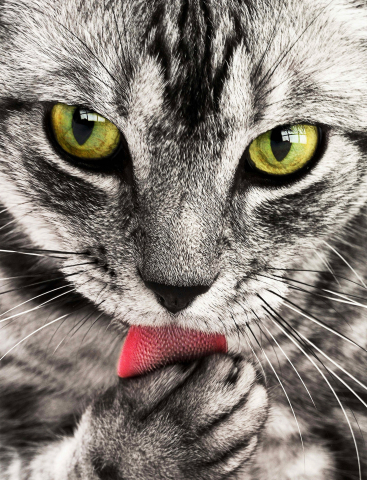Opuštěné polodivoké kočky
I přes značné snahy spolků na ochranu zvířat u nás poslední dobou stoupá počet polodivokých zvířat. Mohou za to hlavně kolonie koček, které se nekontrolovaně množí.
You have probably noticed that cat tongues are quite unique. They are rough and somehow scratchy. It seemed weird to American biologists and therefore they decided to look deeper into it.


You have probably noticed that cat tongues are quite unique. They are rough and somehow scratchy. It seemed weird to American biologists and therefore they decided to look deeper into it.
If have you have already been licked by a cat, you definitely know that its tongue is different from that of a dog for example. Have you been thinking about its reason? American biologists have come up with a possible explanation. They have found out that cat tongue has a very specialised function.
Cats spend up to one third of their awake time taking care of their fur. That is why the surface of the cat tongue is adjusted to cleaning and combing the fur. The surface of the tongue consists of a lot of small backward-facing hooks that are called filiform papilae. They look similar as shark teeth and remind some kind of a velcro. They are firm because they contain keratin.
When the hook of the tongue gets to entangled fur, it gets stuck in it and helps to disentangle it. Unlike the combs, the hooks are mobile. When the cat does not use them, they lie on each other. They straighten up during licking and therefore can perfectly disentangle the fur and comb out loose hair and dirt from the fur.
The scientists created an enlarged model of the cat tongue and have found during its testing that not only can this structure perfectly disentangle the entangled fur but it is also easy to clean. They even got the technology simulating the cat tongue patented because they believe it could be useful in medicine or cosmetics.
But there is another benefit of this structure of the tongue. It helps cats with drinking. The hooks enlarge the surface of the tongue so the cat can catch more water in it (the cat do not create a cup from their tongue while drinking like dogs do). It also serves as a kind of scraper to get meat from bones (after all, cats are still carnivores). The way the hooks are turned toward the rear (deep into the mouth) also helps to move the food in the right way. But it also moves the loose hair into the throat and when you do not comb your cat enough, there can be flocks in its stomach. These can be dangerous if it fails to vomit them.
So what do you think, it is not such a big surprise as a function of the cat tongue, right? :-)


I přes značné snahy spolků na ochranu zvířat u nás poslední dobou stoupá počet polodivokých zvířat. Mohou za to hlavně kolonie koček, které se nekontrolovaně množí.


Plánujete si pořídit fretku a nevíte, jak o tohoto domácího mazlíčka pečovat? Fretka miluje svobodu a pohyb, potřebuje tedy hodně prostoru a zároveň i vaší pozornosti. Přináším proto 10 tipů, jak na specifickou péči o tuto malou šelmu. :)


Pokud bylo jedním z vašich novoročních předsevzetí shodit nějaká ta vánoční kila a být fit, váš psí parťák vám s tím může skvěle pomoct. Navíc psí obezita je jednou z věcí, která veterináře v poslední době trápí nejvíce. Jak na zimní trénink?


Psi trénování na lokalizaci trusu šelem v projektech ochrany přírody občas identifikují špatný druh. A to ve 4 až 45% případů. Studie zveřejněná v časopise Scientific Reports přišla s možným vysvětlením, proč tomu tak je. Na vině nemusí být ani chyba...


Tato africká kočkovitá šelma má na kočku dosti netypickou stavbu těla. Díky svým dlouhým nohám vypadá spíše jako pes. A ač jde o zvíře divoké, často hraje i roli domácího mazlíčka.


Zatímco pro lidi je šanta kočičí léčivou bylinou, na kočky má účinky jiné a mnohem silnější. Víte, proč tato nenáročná trvalka působí na kočky tak opojně?


To, že na nás mají mazlíci blahodárný účinek, je všeobecně známo. Ukazuje se ale, že domácí zvířátko může mít pozitivní vliv i při duševních onemocněních. Alespoň to tvrdí ti, co jimi trpí.


Leden je měsícem předsevzetí. V této době se někteří začínají, jiní možná už ty své vzdali. Pokud jste si nějaký cíl pro nový rok předsevzali, mysleli jste na své mazlíky?


U tohoto plemene, sestry kočky siamské, se snoubí šarm a elegance zevnějšku s přítulnou, extrovertní a hravou povahou.


Brabantíci jsou oblíbení jak ve světě, tak u nás. Krom malého vzrůstu na tom má zásluhu i jejich přátelská a jemná povaha a fakt, že jsou stále dobře naladěni.


Při oslavách nového roku se každoročně ztratí stovky psů. V některých případech jde o nedbalost páníčků, jindy o nešťastnou náhodu. Pojďme se podívat, jak co nejvíce eliminovat toto riziko a jak mazlíkům tento náročný svátek ulehčit.


Tajný život mazlíčků - tak by se dalo nazvat to, co se děje, ve chvíli, kdy za námi zaklapnou domovní dveře. Zajímá vás také, co se odehrává potom? Nabízí se samozřejmá odpověď: Spí. Je tomu ale skutečně tak?